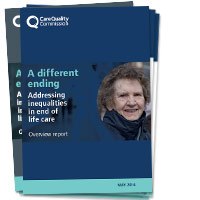
The importance of good end of life care cannot be overestimated. In the majority of cases, people receive end of life care that is caring and compassionate – but people from certain groups in society may experience poorer quality care because providers and commissioners do not always understand or fully consider their specific needs.

Following the recommendation of More care, less pathway, the independent review of the Liverpool Care Pathway, we looked at ‘how dying patients are treated across various settings’. In particular, we focused on people who may be less likely to receive the good end of life care that they need.
We spoke with people who may be less likely to receive good care – whether because of diagnosis, age, ethnic background, sexual orientation, gender identity, disability or social circumstances – to tell us about their experience of end of life care, and the barriers which may prevent them from experiencing good, personalised care at the end of life.
We visited local areas to talk to commissioners, providers and staff about how they address the needs of different groups.
What we found
People from certain groups in society are experiencing poorer quality care at the end of their lives than others because providers and commissioners do not always understand or fully consider their specific needs.
Some commissioners and providers might not be fulfilling their duties under the Equality Act 2010 as all public bodies have a legal duty to consider the needs of a range of equality groups when carrying out their day-to-day work.
Health and care staff are not always having conversations with people early enough about their end of life care. This means they don’t have the opportunity to make plans and choices with their loved-ones about how and where they would prefer to die.
We identified examples of good practice, but found that action is needed to make sure everyone has the same access to high quality, personalised care at the end of their lives, regardless of their diagnosis, age, ethnic background, sexual orientation, gender identity, disability or social circumstances.
A person’s diagnosis, age, ethnic background or social circumstances should not affect the quality of care they receive at any point, but certainly not at the end of their lives.
Professor Steve Field, Chief Inspector of General Practice
Overview report
This report provides the background to the review and the key findings.
A different ending: Addressing inequalities in end of life care (Overview)
Good practice report
Examples of good practice in end of life care that we found through our review.
A different ending: Addressing inequalities in end of life care (Good practice)
People's experiences
We asked people from the following groups to tell us about their experience of end of life care, and the barriers which may prevent them from experiencing good, personalised care at the end of life.
Download
A different ending: Addressing inequalities in end of life care (Overview)
A different ending: Addressing inequalities in end of life care (Good practice)
Join the conversation
Follow the #DifferentEnding hashtag on Twitter
Related information
Press release: Action needed to ensure high quality and personalised care for everyone at the end of their lives, urges CQC.
News: 'A different ending': Our review looking at end of life care published.
Statements of support: See what people are saying about A different ending.
Report: More care, less pathway, the independent review of the Liverpool Care Pathway.